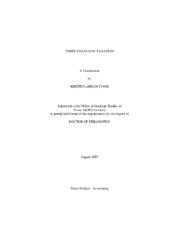| dc.description.abstract | This dissertation contains three essays. The first essay examines the response of equity values to the announcement of a decrease in the capital gains tax rate. The Taxpayer Relief Act of 1997 reduced the long-term capital gains tax rate. News of this rate reduction reached investors in late April to early May of 1997. During the week of this event, firms with appreciated stock positions, average holding periods of at least one year, and individual marginal investors reported lower returns than companies lacking one or more of these characteristics. The second essay builds on recent research reporting that firms establish target capital structures by weighing the costs and benefits of debt and that adjustment costs dictate how rapidly companies move toward optimal leverage ratios. If tax considerations impact debt structures adjust more rapidly than companies below the goals because low-tax firms have less need of interest deductions to decrease tax burdens and, thus, sacrifice less tax benefit when retiring debt. The third essay demonstrates that manufacturing firms manipulate production to manage earnings and examines whether tax incentives magnify or temper this strategy. Companies that exceed the quarterly consensus analyst forecasts absent the earnings effects of discretionary inventory changes cut production and create an earnings cookie jar for future quarters. For this sub-sample, companies make larger discretionary inventory decreases as the marginal tax rates rise in the fourth quarter relative to the first three quarters. In contrast, the sub-sample of firms that miss income goals without manipulating production use discretionary inventory increases to enhance earnings and potentially reach benchmarks. Higher tax rates do not impede miss firms from managing earnings upward; however, considerations of tax timing dissuade these companies from opportunistically manipulating production in the fourth quarter.levels of the firms, taxes are also likely to influence the rates of adjustment to target levels. Among high-tax firms, companies below the optimal leverage ratios respond more quickly than companies above the targets because high-tax firms can better utilize the interest deductions generated by issuing additional debt to reduce tax liabilities. Among low-tax firms, companies above the target capital | en |


